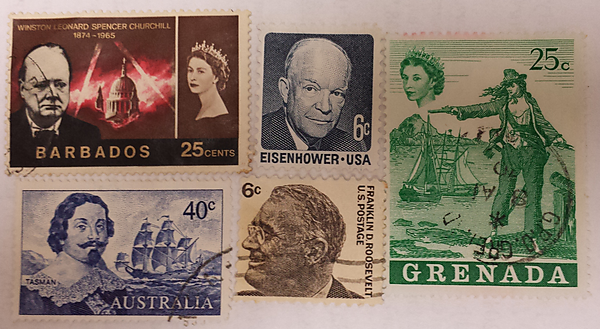My mom recently handed me a large bag of stamps she had collected as a child. There are thousands of stamps from about 100 countries, most from the 1910s to the 1950s. It’s a treasure trove.
My daughters and I started digging through them, and we checked out Internet resources on philately, a hobby I know little about.
Here are a few observations:
- Most old postmarked stamps are worth relatively little. I guess the reason is high supply and low demand.
- The world’s first postage stamp was the British Penny Black in 1840, which portrayed Queen Victoria. Stamps were introduced as part of U.K. postal reforms to cut government waste and mismanagement. The first U.S. stamps in 1847 showed Franklin and Washington. Canada’s first stamp in 1851 did not show a government leader, but instead the clever and industrious beaver.
- Great Britain used to rule a vast area of the globe, and dozens of nations had the British monarch on their stamps. And many countries used to honor American liberty on their stamps, such as these fascinating issues from the 1930s. I doubt whether that happens much anymore.
- Small countries often have attractive stamps. Some of the prettiest I have are from the Caribbean and Africa. The least attractive are from Germany and the United States. In a competitive world, small countries know that they must put in an extra effort. (See photo). It’s a similar situation with corporate tax rates today: small countries tend to have low and competitive rates, but the United States has an ugly 40 percent rate.
- U.S. postage stamps and currency have long been printed by the government, although postage stamp printing was privatized in 2005. By contrast, Canadian stamps and currency have long been printed by private firms, such as the Canadian Bank Note Company.
- Hyperflation plays out on stamps. I have a Deutsches Reich 5 mark stamp that is stamped with heavy black ink “2 Millionen.” Another says “4 Millionen.” (See photo). Here is the interesting story of these relics of government folly.
- I have a German Democratic Republic stamp with a cute portrait of Marx, Engels, and Lenin. (See photo). The communist government is showing off that it has computers and oil refineries.
In the stamp bag, my mom saved an October 1948 Woman’s Day article “Inside Stories about Stamps.” Under the heading “Private Enterprise,” it says “until the 1880s, private firms in several American cities operated postal systems of their own in open—often violent—defiance of federal postal laws. Probably the last of these carriers was the St. Louis City Delivery Company which the Post Office finally suppressed in 1883.”
Ironically, the federal government imposed the Sherman Antitrust Act only seven years later to stomp out monopolies, but not government monopolies of course.
I’ll have more on private postal competition in the 19th century in a future blogpost. Meanwhile, here’s Tad DeHaven on postal reform and me on privatizing the Royal Mail.



